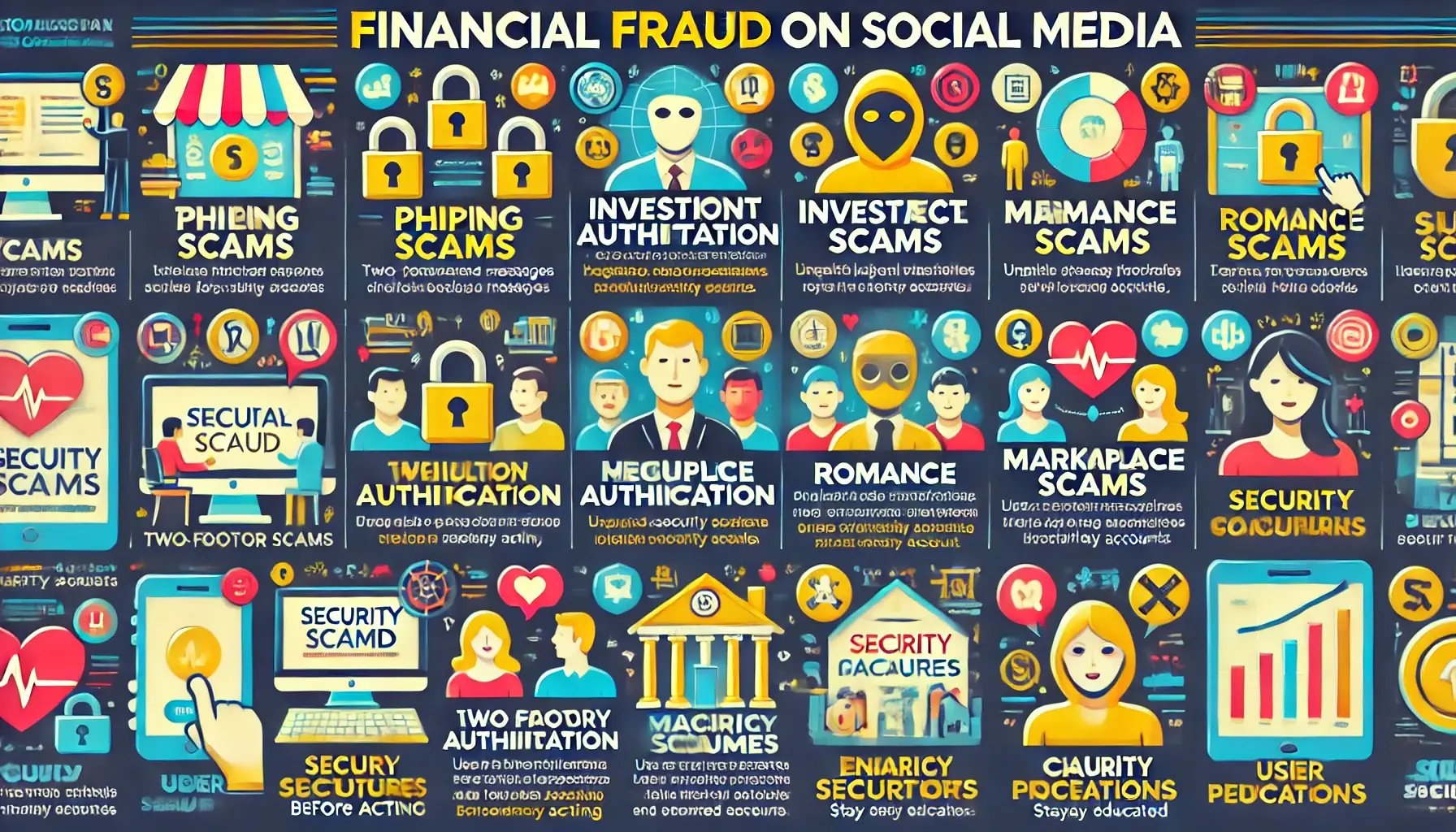The payment industry is at the forefront of digital transformation, enabling seamless transactions...
Combating Financial Fraud through Social Media
 In today’s digital age, social media platforms have become integral to our daily lives, offering unparalleled connectivity and information sharing. However, this widespread usage also makes social media a prime target for financial fraud. Fraudsters exploit the trust, anonymity, and wide reach of these platforms to deceive users. This article explores the various types of financial fraud prevalent on social media, provides detailed examples, and offers comprehensive strategies to prevent such fraud.
In today’s digital age, social media platforms have become integral to our daily lives, offering unparalleled connectivity and information sharing. However, this widespread usage also makes social media a prime target for financial fraud. Fraudsters exploit the trust, anonymity, and wide reach of these platforms to deceive users. This article explores the various types of financial fraud prevalent on social media, provides detailed examples, and offers comprehensive strategies to prevent such fraud.Types of Financial Fraud on Social Media
-
Phishing Scams Phishing scams involve fraudsters sending deceptive messages to trick individuals into revealing personal and financial information. These messages often appear to come from legitimate sources.
Example: A user receives a message on Facebook claiming to be from their bank, requesting them to verify their account information by clicking on a provided link. The link directs them to a fake website that looks identical to the bank’s official site, where they unknowingly enter their login credentials, which are then stolen by the scammers.
-
Investment Scams Investment scams lure victims with promises of high returns and low risk. These scams can be particularly convincing when promoted by fake profiles posing as successful investors.
Example: On Instagram, a user comes across a profile claiming to have turned a $1,000 investment into $10,000 within a month. The profile showcases luxurious lifestyles and testimonials. Trusting the visuals, the user invests money, only to find out later that the profile was a scam, and their money is gone.
-
Romance Scams In romance scams, fraudsters create fake profiles to form relationships with victims, eventually manipulating them into sending money.
Example: A user on a dating app builds a relationship with someone who claims to be an overseas contractor. After gaining the user’s trust, the scammer asks for money to deal with an "emergency" situation, such as medical bills or travel expenses. The victim, believing in the authenticity of the relationship, sends the money, which the scammer then absconds with.
-
Marketplace Scams Fraudsters post fake advertisements for goods or services that do not exist, enticing users to pay upfront.
Example: On Facebook Marketplace, a user finds an unbeatable deal on a high-end smartphone. They contact the seller and are asked to pay via a peer-to-peer payment app. After the payment is made, the seller disappears, and the phone is never delivered.
-
Charity Scams These scams exploit the goodwill of people by creating fake charity appeals, often following disasters or during holidays.
Example: After a natural disaster, a user sees a post on Twitter from what appears to be a reputable charity asking for donations. The post contains a link to a donation page. The user donates, only to later discover that the charity and the donation page were fraudulent.
Preventative Measures
To combat these types of fraud, several strategies can be employed at both the platform and user levels.
1. Education and Awareness
Public Awareness Campaigns
- Governments and organizations can launch campaigns to educate the public about the risks of social media fraud and how to recognize it.
User Training
- Social media platforms can provide training modules that teach users how to identify and avoid scams.
Example: Twitter could implement an educational pop-up that appears when users receive messages from unknown accounts, reminding them to be cautious and providing tips to identify potential scams.
2. Enhanced Security Measures
Two-Factor Authentication (2FA)
- Encouraging or requiring 2FA adds an extra layer of security, making it more difficult for fraudsters to access accounts.
Regular Security Updates
- Social media platforms should regularly update their security protocols to stay ahead of evolving threats.
Example: Facebook can implement mandatory 2FA for all financial transactions and periodically prompt users to update their security settings.
3. Robust Verification Processes
Verified Accounts
- Verification badges help users identify authentic profiles of public figures and businesses.
Identity Verification
- Platforms should implement processes to verify the identity of users and businesses, especially those engaging in financial transactions.
Example: Instagram can introduce a more rigorous verification process for accounts that promote financial services or investment opportunities, ensuring they are legitimate.
4. Proactive Monitoring and Reporting
AI and Machine Learning
- Advanced algorithms can be used to detect and block fraudulent activities.
User Reporting Mechanisms
- Simplifying the process for users to report suspicious activities and ensuring timely action can help mitigate fraud.
Example: Twitter could enhance its reporting system by allowing users to flag suspicious accounts directly from their profiles and ensuring these reports are reviewed promptly by a dedicated fraud prevention team.
5. Regulatory Compliance
Adherence to Regulations
- Social media companies should comply with financial regulations to detect and prevent fraud.
Collaboration with Authorities
- Fostering cooperation between social media platforms and law enforcement agencies can enhance the detection and prosecution of fraudsters.
Example: Facebook can collaborate with financial regulators to monitor and report suspicious financial activities, ensuring compliance with anti-fraud regulations.
6. Data Privacy and Protection
Limit Data Sharing
- Minimizing the amount of personal information shared on social media can reduce the risk of fraud.
Privacy Settings
- Educating users on how to adjust their privacy settings to protect personal information is crucial.
Example: Instagram could create a tutorial that guides users through the process of tightening their privacy settings, emphasizing the importance of limiting who can see their posts and personal information.
Individual User Precautions
Users can also take steps to protect themselves from financial fraud on social media:
- Be Skeptical of Unsolicited Messages
- Do not trust messages from unknown sources, especially those requesting personal or financial information.
Example: If a user receives a message on Facebook claiming they have won a lottery they never entered, they should avoid clicking on any links and report the message as suspicious.
- Verify Before Acting
- Cross-check information and verify the identity of businesses or individuals before engaging in financial transactions.
Example: Before investing in a scheme advertised on Instagram, a user should research the company, check for reviews, and confirm its legitimacy through official channels.
- Use Strong Passwords
- Utilize strong, unique passwords for social media accounts and change them regularly.
Example: A user can employ a password manager to generate and store complex passwords for their social media accounts, ensuring each one is different.
- Enable Security Features
- Take advantage of security features like two-factor authentication and account alerts.
Example: On Twitter, users should enable login alerts to receive notifications whenever their account is accessed from a new device.
- Educate Themselves
- Stay informed about common types of scams and how to avoid them.
Example: Users can regularly visit their social media platforms’ help centers to stay updated on the latest fraud trends and prevention tips.
By combining educational efforts, robust security measures, and proactive monitoring, both social media platforms and users can significantly reduce the risk of financial fraud. Through awareness, vigilance, and the use of advanced technologies, the digital space can become a safer environment for all users.



